Review and Analysis of the NSW Ministry of Health E-health Strategy
VerifiedAdded on 2023/06/10
|10
|1771
|99
Report
AI Summary
This report provides an analysis of the NSW Ministry of Health's e-health strategy, focusing on the digitalization of healthcare services. It reviews the state's plan, including the implementation of electronic health records, mobile applications, cloud computing, and other information and communication technologies (ICT). The report explores the strategic themes and priorities of the e-health blueprint, examining the progress and targets of electronic medical records and other technological advancements. It discusses the findings, highlighting challenges such as a lack of trained workforce and the need for improved communication technology. Furthermore, the report offers recommendations for enhancing the e-health infrastructure, including incorporating innovative implementation strategies, collaborative decision-making, and robust cybersecurity measures to protect patient data and ensure the success of digital health initiatives. The report emphasizes the importance of incorporating big data technology and 5G networking to improve data management and communication within the healthcare system.
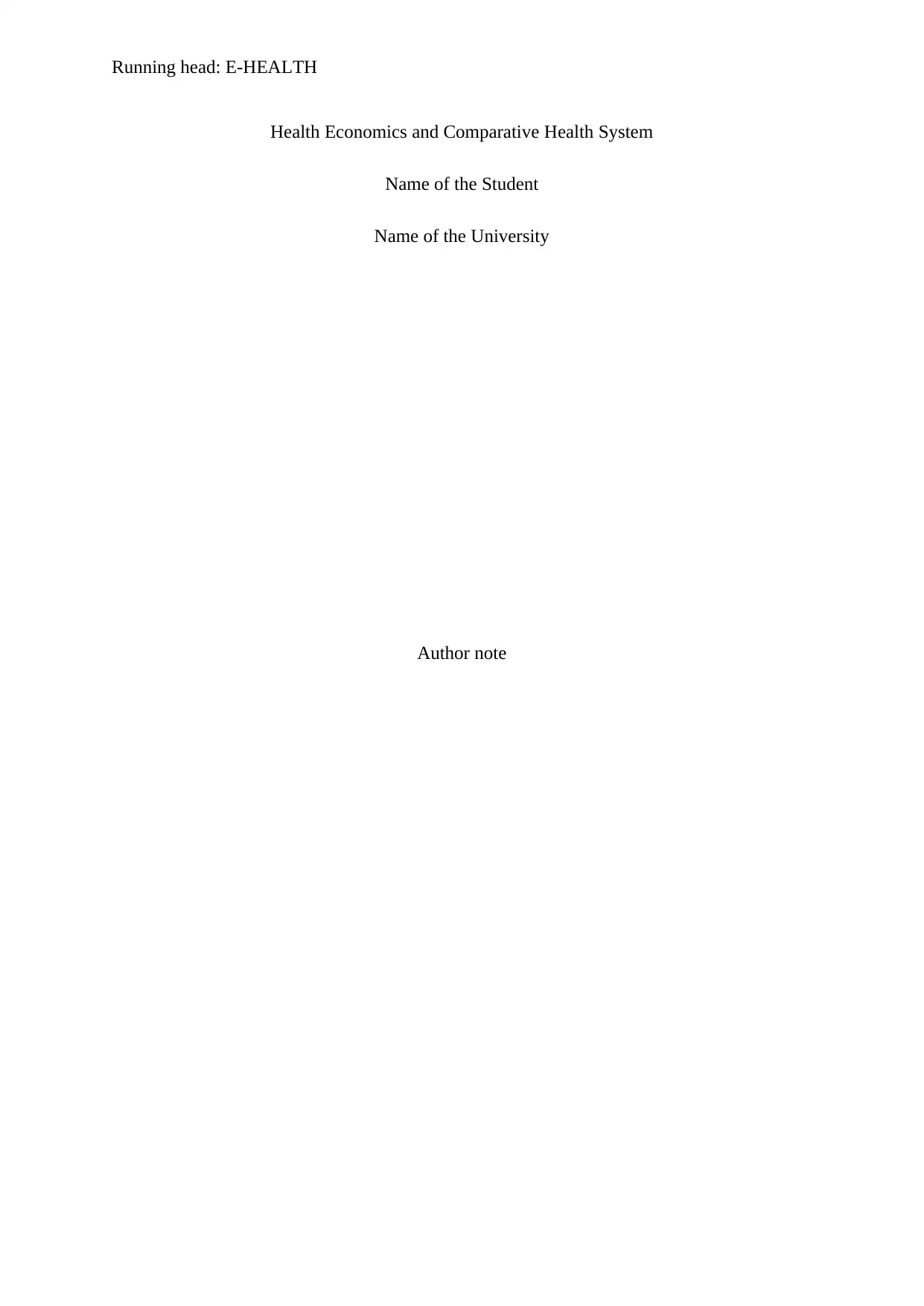
Running head: E-HEALTH
Health Economics and Comparative Health System
Name of the Student
Name of the University
Author note
Health Economics and Comparative Health System
Name of the Student
Name of the University
Author note
Paraphrase This Document
Need a fresh take? Get an instant paraphrase of this document with our AI Paraphraser
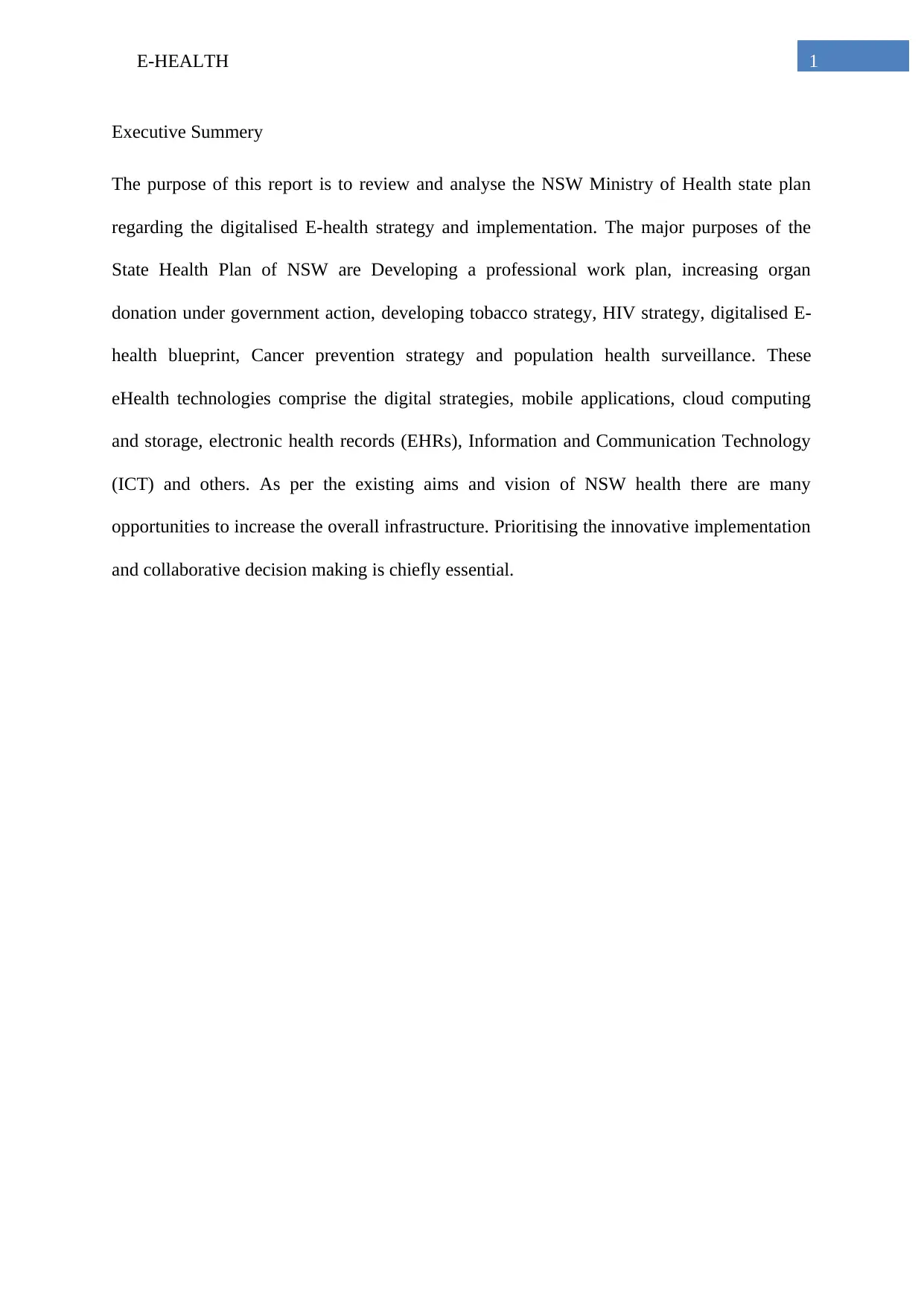
1E-HEALTH
Executive Summery
The purpose of this report is to review and analyse the NSW Ministry of Health state plan
regarding the digitalised E-health strategy and implementation. The major purposes of the
State Health Plan of NSW are Developing a professional work plan, increasing organ
donation under government action, developing tobacco strategy, HIV strategy, digitalised E-
health blueprint, Cancer prevention strategy and population health surveillance. These
eHealth technologies comprise the digital strategies, mobile applications, cloud computing
and storage, electronic health records (EHRs), Information and Communication Technology
(ICT) and others. As per the existing aims and vision of NSW health there are many
opportunities to increase the overall infrastructure. Prioritising the innovative implementation
and collaborative decision making is chiefly essential.
Executive Summery
The purpose of this report is to review and analyse the NSW Ministry of Health state plan
regarding the digitalised E-health strategy and implementation. The major purposes of the
State Health Plan of NSW are Developing a professional work plan, increasing organ
donation under government action, developing tobacco strategy, HIV strategy, digitalised E-
health blueprint, Cancer prevention strategy and population health surveillance. These
eHealth technologies comprise the digital strategies, mobile applications, cloud computing
and storage, electronic health records (EHRs), Information and Communication Technology
(ICT) and others. As per the existing aims and vision of NSW health there are many
opportunities to increase the overall infrastructure. Prioritising the innovative implementation
and collaborative decision making is chiefly essential.
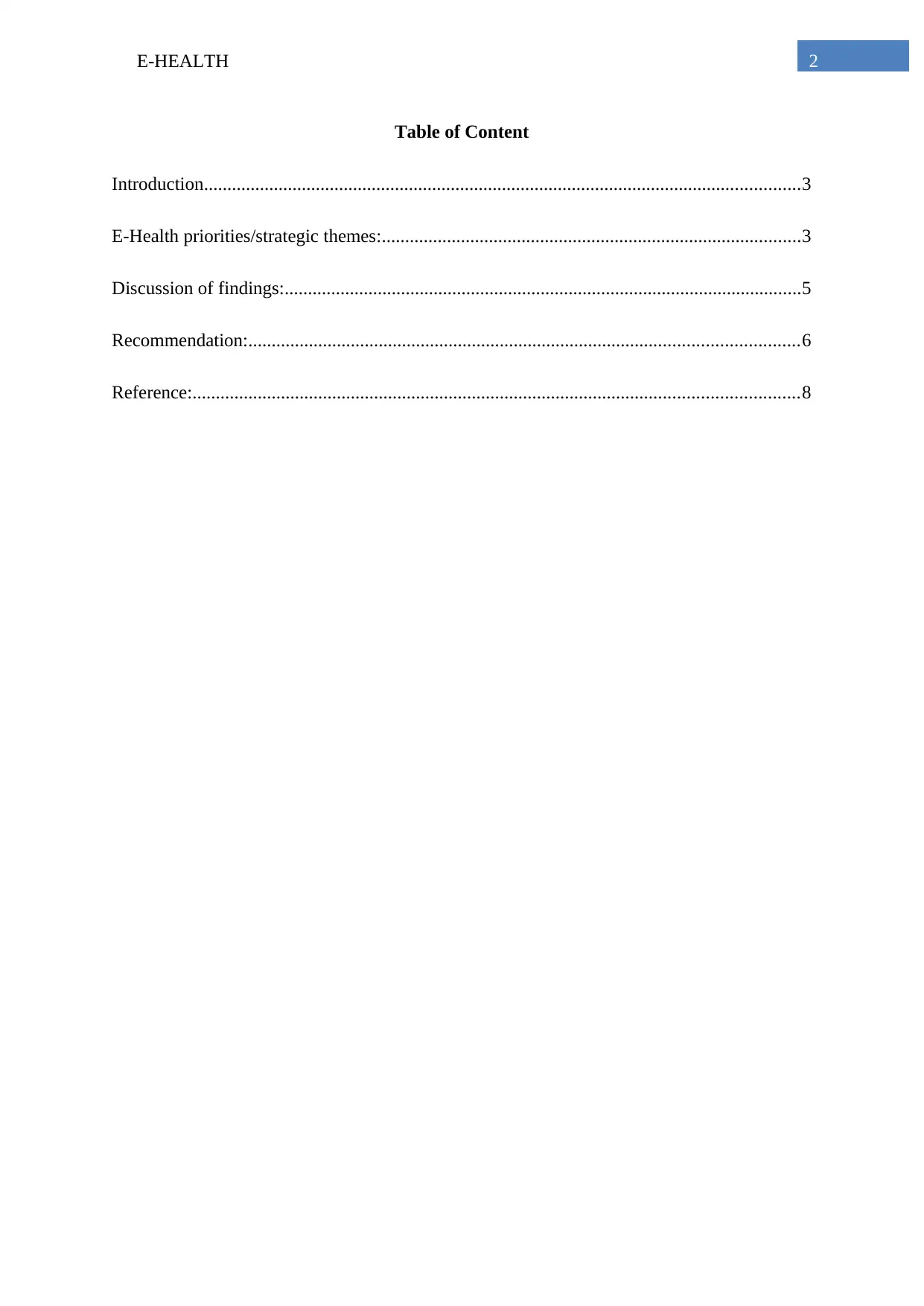
2E-HEALTH
Table of Content
Introduction................................................................................................................................3
E-Health priorities/strategic themes:..........................................................................................3
Discussion of findings:...............................................................................................................5
Recommendation:......................................................................................................................6
Reference:..................................................................................................................................8
Table of Content
Introduction................................................................................................................................3
E-Health priorities/strategic themes:..........................................................................................3
Discussion of findings:...............................................................................................................5
Recommendation:......................................................................................................................6
Reference:..................................................................................................................................8
⊘ This is a preview!⊘
Do you want full access?
Subscribe today to unlock all pages.

Trusted by 1+ million students worldwide
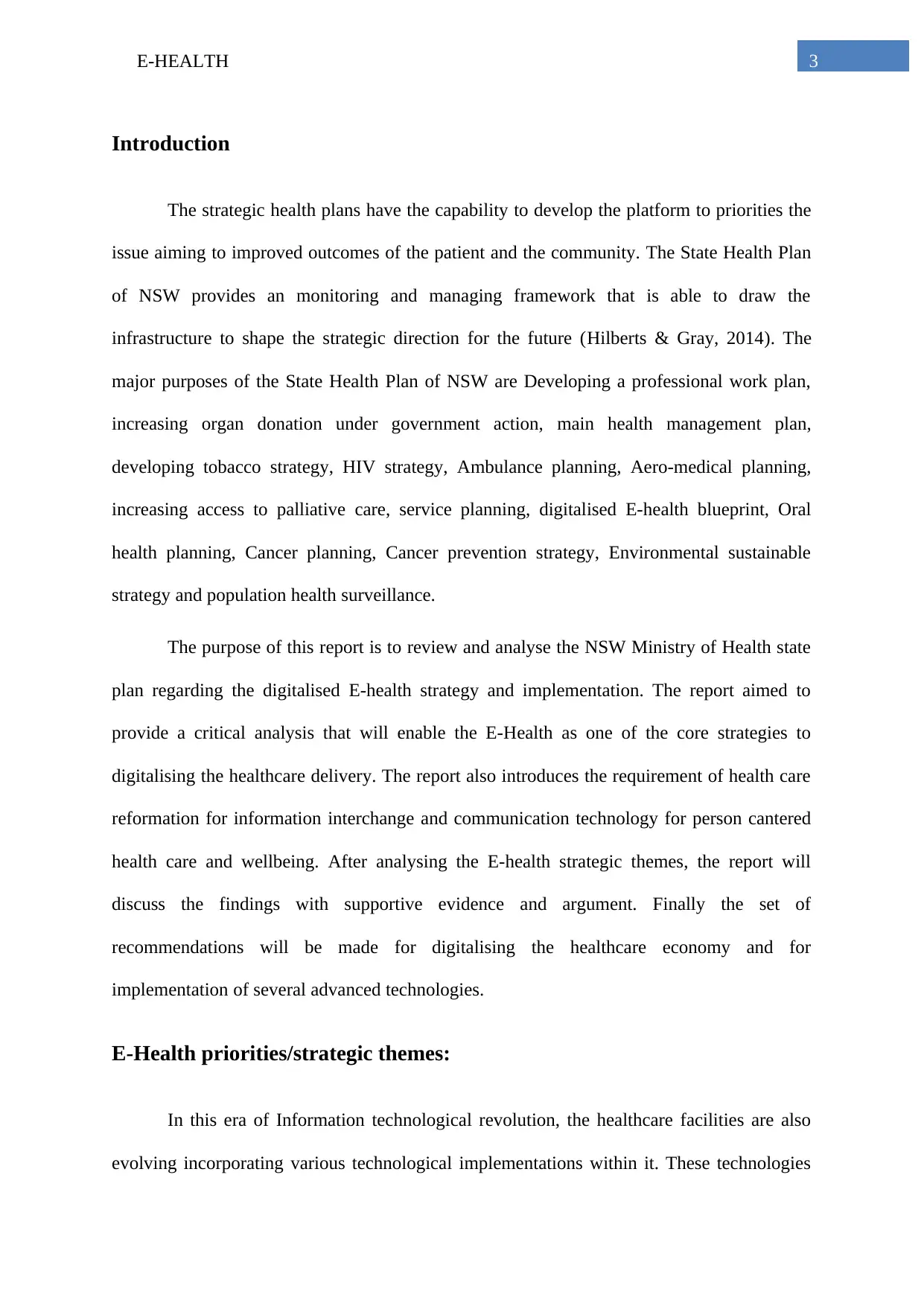
3E-HEALTH
Introduction
The strategic health plans have the capability to develop the platform to priorities the
issue aiming to improved outcomes of the patient and the community. The State Health Plan
of NSW provides an monitoring and managing framework that is able to draw the
infrastructure to shape the strategic direction for the future (Hilberts & Gray, 2014). The
major purposes of the State Health Plan of NSW are Developing a professional work plan,
increasing organ donation under government action, main health management plan,
developing tobacco strategy, HIV strategy, Ambulance planning, Aero-medical planning,
increasing access to palliative care, service planning, digitalised E-health blueprint, Oral
health planning, Cancer planning, Cancer prevention strategy, Environmental sustainable
strategy and population health surveillance.
The purpose of this report is to review and analyse the NSW Ministry of Health state
plan regarding the digitalised E-health strategy and implementation. The report aimed to
provide a critical analysis that will enable the E-Health as one of the core strategies to
digitalising the healthcare delivery. The report also introduces the requirement of health care
reformation for information interchange and communication technology for person cantered
health care and wellbeing. After analysing the E-health strategic themes, the report will
discuss the findings with supportive evidence and argument. Finally the set of
recommendations will be made for digitalising the healthcare economy and for
implementation of several advanced technologies.
E-Health priorities/strategic themes:
In this era of Information technological revolution, the healthcare facilities are also
evolving incorporating various technological implementations within it. These technologies
Introduction
The strategic health plans have the capability to develop the platform to priorities the
issue aiming to improved outcomes of the patient and the community. The State Health Plan
of NSW provides an monitoring and managing framework that is able to draw the
infrastructure to shape the strategic direction for the future (Hilberts & Gray, 2014). The
major purposes of the State Health Plan of NSW are Developing a professional work plan,
increasing organ donation under government action, main health management plan,
developing tobacco strategy, HIV strategy, Ambulance planning, Aero-medical planning,
increasing access to palliative care, service planning, digitalised E-health blueprint, Oral
health planning, Cancer planning, Cancer prevention strategy, Environmental sustainable
strategy and population health surveillance.
The purpose of this report is to review and analyse the NSW Ministry of Health state
plan regarding the digitalised E-health strategy and implementation. The report aimed to
provide a critical analysis that will enable the E-Health as one of the core strategies to
digitalising the healthcare delivery. The report also introduces the requirement of health care
reformation for information interchange and communication technology for person cantered
health care and wellbeing. After analysing the E-health strategic themes, the report will
discuss the findings with supportive evidence and argument. Finally the set of
recommendations will be made for digitalising the healthcare economy and for
implementation of several advanced technologies.
E-Health priorities/strategic themes:
In this era of Information technological revolution, the healthcare facilities are also
evolving incorporating various technological implementations within it. These technologies
Paraphrase This Document
Need a fresh take? Get an instant paraphrase of this document with our AI Paraphraser
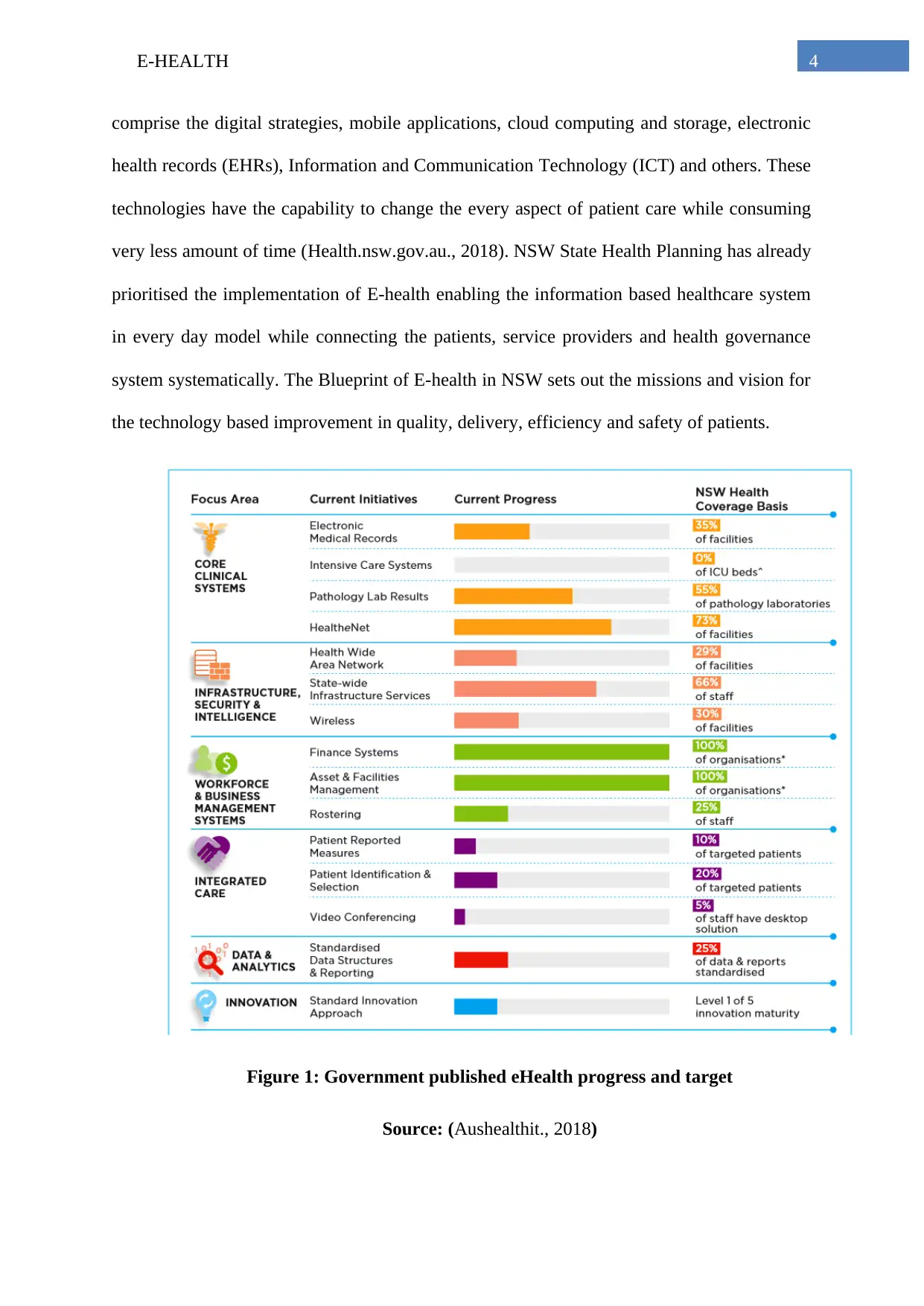
4E-HEALTH
comprise the digital strategies, mobile applications, cloud computing and storage, electronic
health records (EHRs), Information and Communication Technology (ICT) and others. These
technologies have the capability to change the every aspect of patient care while consuming
very less amount of time (Health.nsw.gov.au., 2018). NSW State Health Planning has already
prioritised the implementation of E-health enabling the information based healthcare system
in every day model while connecting the patients, service providers and health governance
system systematically. The Blueprint of E-health in NSW sets out the missions and vision for
the technology based improvement in quality, delivery, efficiency and safety of patients.
Figure 1: Government published eHealth progress and target
Source: (Aushealthit., 2018)
comprise the digital strategies, mobile applications, cloud computing and storage, electronic
health records (EHRs), Information and Communication Technology (ICT) and others. These
technologies have the capability to change the every aspect of patient care while consuming
very less amount of time (Health.nsw.gov.au., 2018). NSW State Health Planning has already
prioritised the implementation of E-health enabling the information based healthcare system
in every day model while connecting the patients, service providers and health governance
system systematically. The Blueprint of E-health in NSW sets out the missions and vision for
the technology based improvement in quality, delivery, efficiency and safety of patients.
Figure 1: Government published eHealth progress and target
Source: (Aushealthit., 2018)
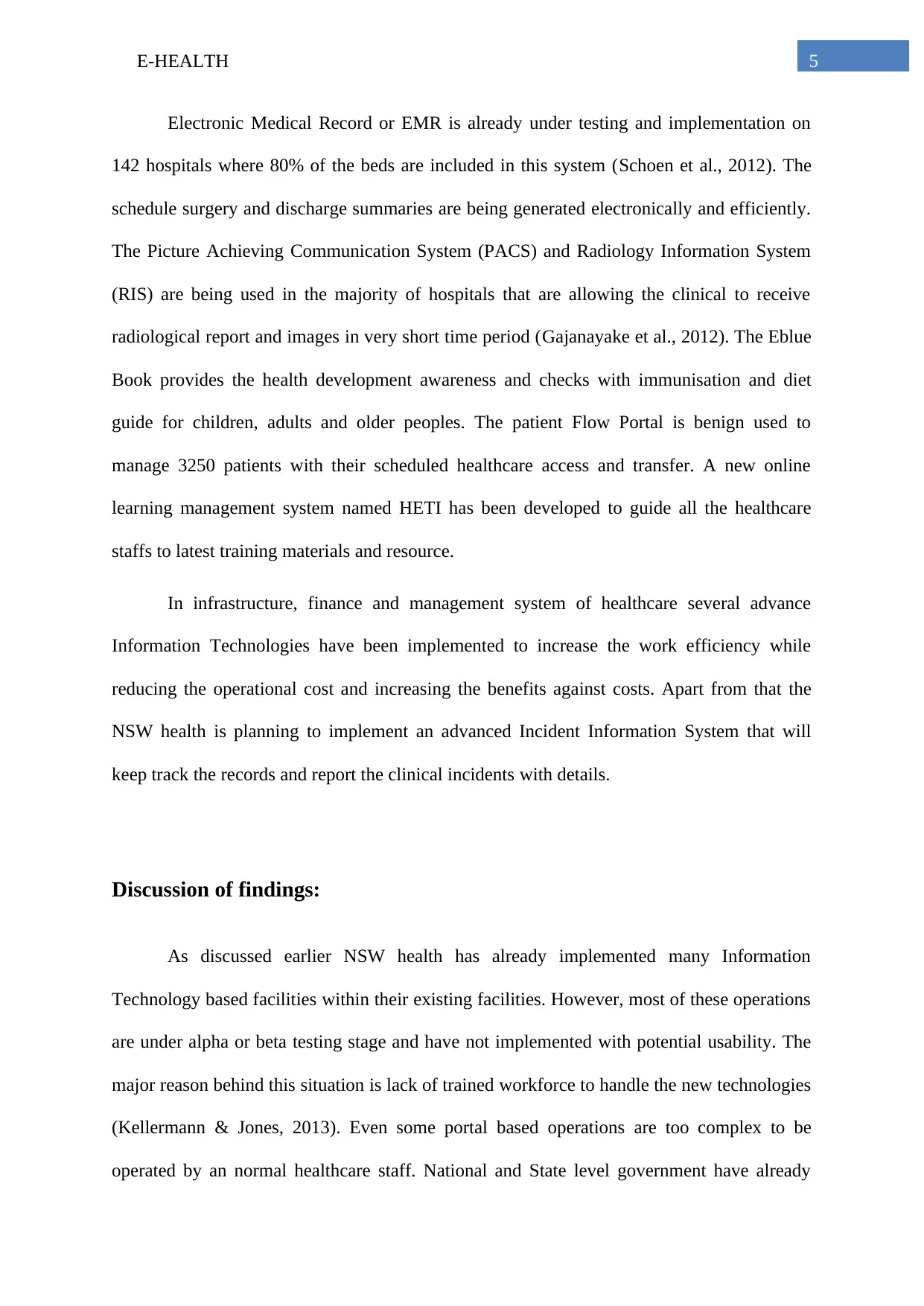
5E-HEALTH
Electronic Medical Record or EMR is already under testing and implementation on
142 hospitals where 80% of the beds are included in this system (Schoen et al., 2012). The
schedule surgery and discharge summaries are being generated electronically and efficiently.
The Picture Achieving Communication System (PACS) and Radiology Information System
(RIS) are being used in the majority of hospitals that are allowing the clinical to receive
radiological report and images in very short time period (Gajanayake et al., 2012). The Eblue
Book provides the health development awareness and checks with immunisation and diet
guide for children, adults and older peoples. The patient Flow Portal is benign used to
manage 3250 patients with their scheduled healthcare access and transfer. A new online
learning management system named HETI has been developed to guide all the healthcare
staffs to latest training materials and resource.
In infrastructure, finance and management system of healthcare several advance
Information Technologies have been implemented to increase the work efficiency while
reducing the operational cost and increasing the benefits against costs. Apart from that the
NSW health is planning to implement an advanced Incident Information System that will
keep track the records and report the clinical incidents with details.
Discussion of findings:
As discussed earlier NSW health has already implemented many Information
Technology based facilities within their existing facilities. However, most of these operations
are under alpha or beta testing stage and have not implemented with potential usability. The
major reason behind this situation is lack of trained workforce to handle the new technologies
(Kellermann & Jones, 2013). Even some portal based operations are too complex to be
operated by an normal healthcare staff. National and State level government have already
Electronic Medical Record or EMR is already under testing and implementation on
142 hospitals where 80% of the beds are included in this system (Schoen et al., 2012). The
schedule surgery and discharge summaries are being generated electronically and efficiently.
The Picture Achieving Communication System (PACS) and Radiology Information System
(RIS) are being used in the majority of hospitals that are allowing the clinical to receive
radiological report and images in very short time period (Gajanayake et al., 2012). The Eblue
Book provides the health development awareness and checks with immunisation and diet
guide for children, adults and older peoples. The patient Flow Portal is benign used to
manage 3250 patients with their scheduled healthcare access and transfer. A new online
learning management system named HETI has been developed to guide all the healthcare
staffs to latest training materials and resource.
In infrastructure, finance and management system of healthcare several advance
Information Technologies have been implemented to increase the work efficiency while
reducing the operational cost and increasing the benefits against costs. Apart from that the
NSW health is planning to implement an advanced Incident Information System that will
keep track the records and report the clinical incidents with details.
Discussion of findings:
As discussed earlier NSW health has already implemented many Information
Technology based facilities within their existing facilities. However, most of these operations
are under alpha or beta testing stage and have not implemented with potential usability. The
major reason behind this situation is lack of trained workforce to handle the new technologies
(Kellermann & Jones, 2013). Even some portal based operations are too complex to be
operated by an normal healthcare staff. National and State level government have already
⊘ This is a preview!⊘
Do you want full access?
Subscribe today to unlock all pages.

Trusted by 1+ million students worldwide
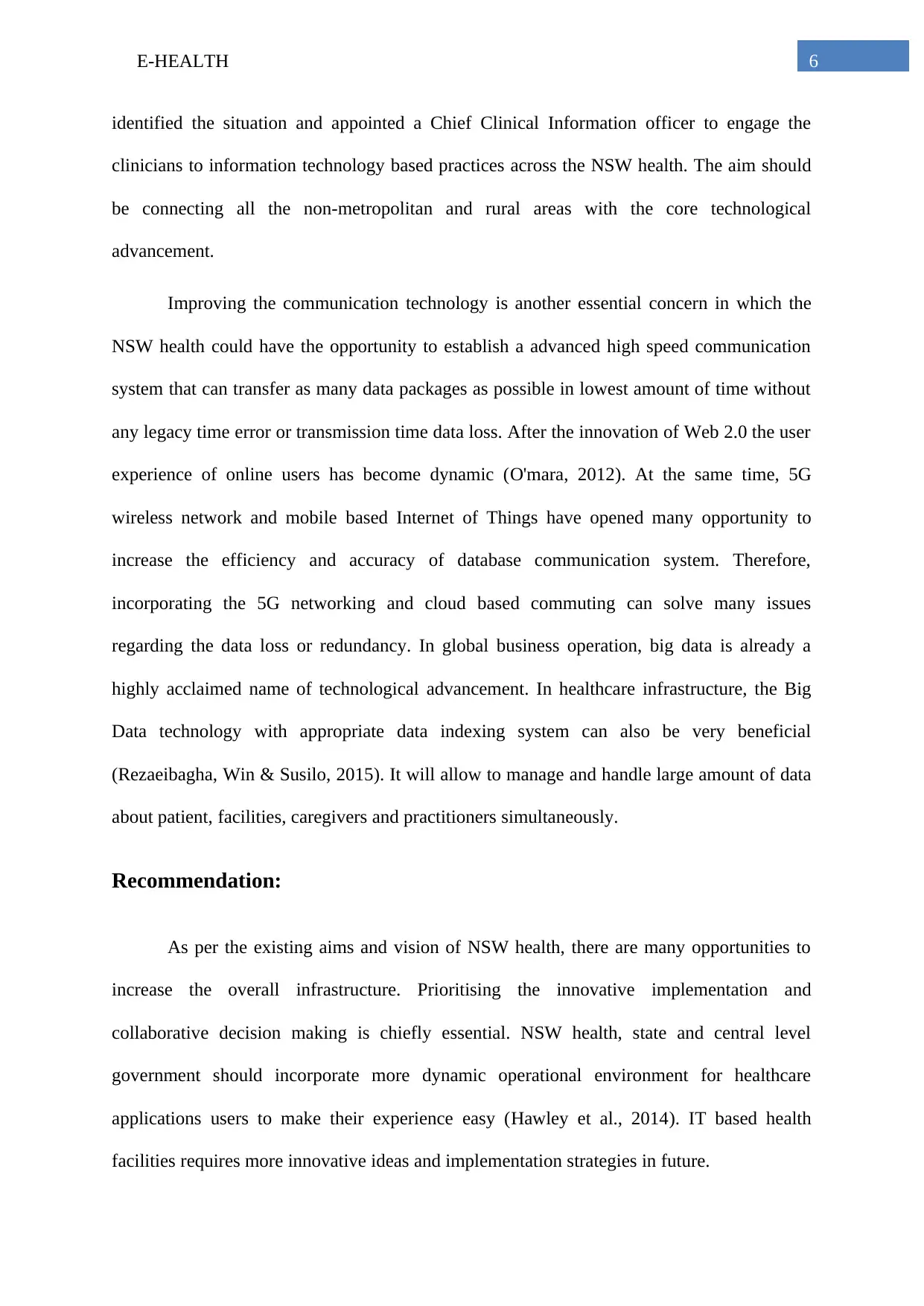
6E-HEALTH
identified the situation and appointed a Chief Clinical Information officer to engage the
clinicians to information technology based practices across the NSW health. The aim should
be connecting all the non-metropolitan and rural areas with the core technological
advancement.
Improving the communication technology is another essential concern in which the
NSW health could have the opportunity to establish a advanced high speed communication
system that can transfer as many data packages as possible in lowest amount of time without
any legacy time error or transmission time data loss. After the innovation of Web 2.0 the user
experience of online users has become dynamic (O'mara, 2012). At the same time, 5G
wireless network and mobile based Internet of Things have opened many opportunity to
increase the efficiency and accuracy of database communication system. Therefore,
incorporating the 5G networking and cloud based commuting can solve many issues
regarding the data loss or redundancy. In global business operation, big data is already a
highly acclaimed name of technological advancement. In healthcare infrastructure, the Big
Data technology with appropriate data indexing system can also be very beneficial
(Rezaeibagha, Win & Susilo, 2015). It will allow to manage and handle large amount of data
about patient, facilities, caregivers and practitioners simultaneously.
Recommendation:
As per the existing aims and vision of NSW health, there are many opportunities to
increase the overall infrastructure. Prioritising the innovative implementation and
collaborative decision making is chiefly essential. NSW health, state and central level
government should incorporate more dynamic operational environment for healthcare
applications users to make their experience easy (Hawley et al., 2014). IT based health
facilities requires more innovative ideas and implementation strategies in future.
identified the situation and appointed a Chief Clinical Information officer to engage the
clinicians to information technology based practices across the NSW health. The aim should
be connecting all the non-metropolitan and rural areas with the core technological
advancement.
Improving the communication technology is another essential concern in which the
NSW health could have the opportunity to establish a advanced high speed communication
system that can transfer as many data packages as possible in lowest amount of time without
any legacy time error or transmission time data loss. After the innovation of Web 2.0 the user
experience of online users has become dynamic (O'mara, 2012). At the same time, 5G
wireless network and mobile based Internet of Things have opened many opportunity to
increase the efficiency and accuracy of database communication system. Therefore,
incorporating the 5G networking and cloud based commuting can solve many issues
regarding the data loss or redundancy. In global business operation, big data is already a
highly acclaimed name of technological advancement. In healthcare infrastructure, the Big
Data technology with appropriate data indexing system can also be very beneficial
(Rezaeibagha, Win & Susilo, 2015). It will allow to manage and handle large amount of data
about patient, facilities, caregivers and practitioners simultaneously.
Recommendation:
As per the existing aims and vision of NSW health, there are many opportunities to
increase the overall infrastructure. Prioritising the innovative implementation and
collaborative decision making is chiefly essential. NSW health, state and central level
government should incorporate more dynamic operational environment for healthcare
applications users to make their experience easy (Hawley et al., 2014). IT based health
facilities requires more innovative ideas and implementation strategies in future.
Paraphrase This Document
Need a fresh take? Get an instant paraphrase of this document with our AI Paraphraser
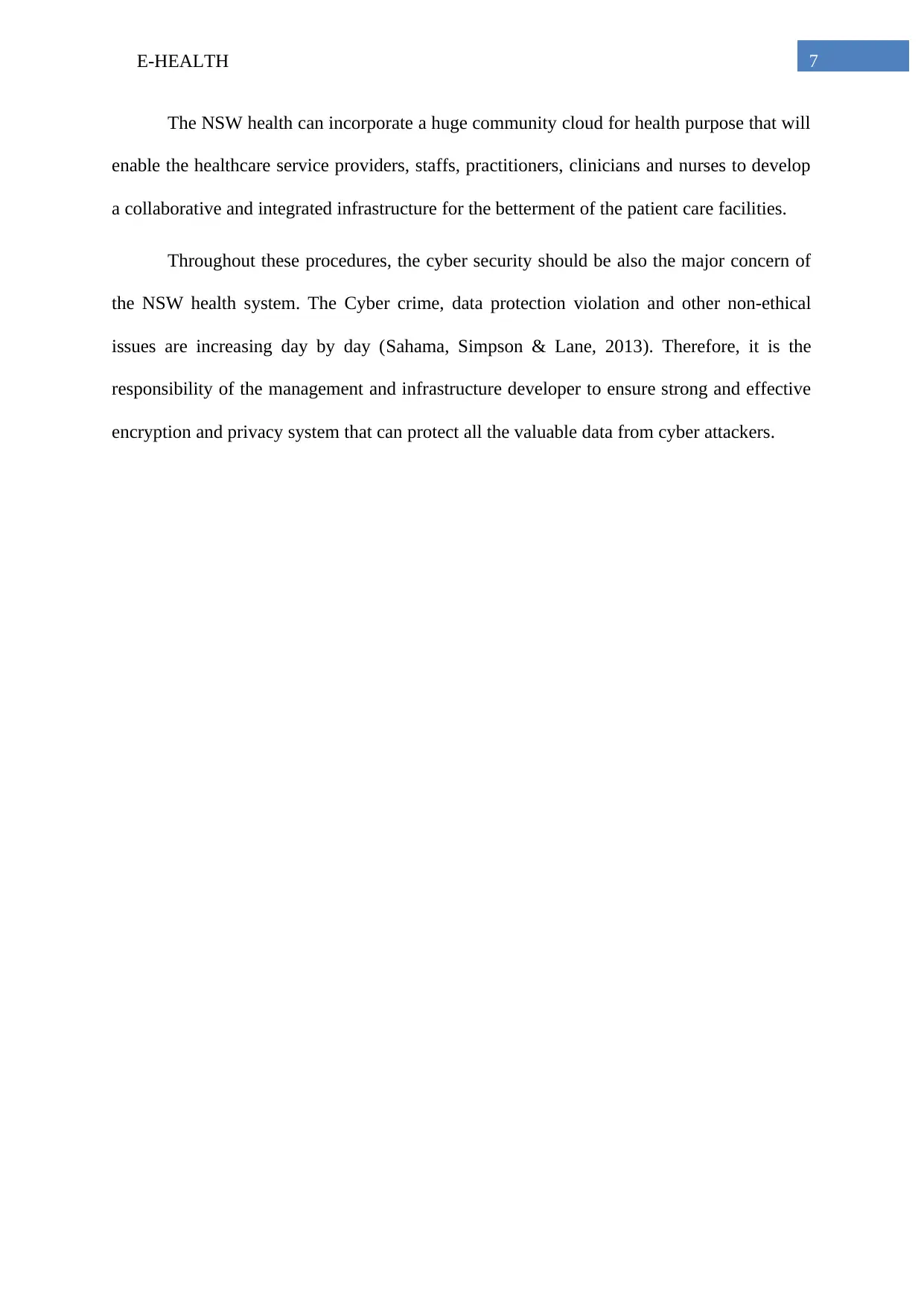
7E-HEALTH
The NSW health can incorporate a huge community cloud for health purpose that will
enable the healthcare service providers, staffs, practitioners, clinicians and nurses to develop
a collaborative and integrated infrastructure for the betterment of the patient care facilities.
Throughout these procedures, the cyber security should be also the major concern of
the NSW health system. The Cyber crime, data protection violation and other non-ethical
issues are increasing day by day (Sahama, Simpson & Lane, 2013). Therefore, it is the
responsibility of the management and infrastructure developer to ensure strong and effective
encryption and privacy system that can protect all the valuable data from cyber attackers.
The NSW health can incorporate a huge community cloud for health purpose that will
enable the healthcare service providers, staffs, practitioners, clinicians and nurses to develop
a collaborative and integrated infrastructure for the betterment of the patient care facilities.
Throughout these procedures, the cyber security should be also the major concern of
the NSW health system. The Cyber crime, data protection violation and other non-ethical
issues are increasing day by day (Sahama, Simpson & Lane, 2013). Therefore, it is the
responsibility of the management and infrastructure developer to ensure strong and effective
encryption and privacy system that can protect all the valuable data from cyber attackers.
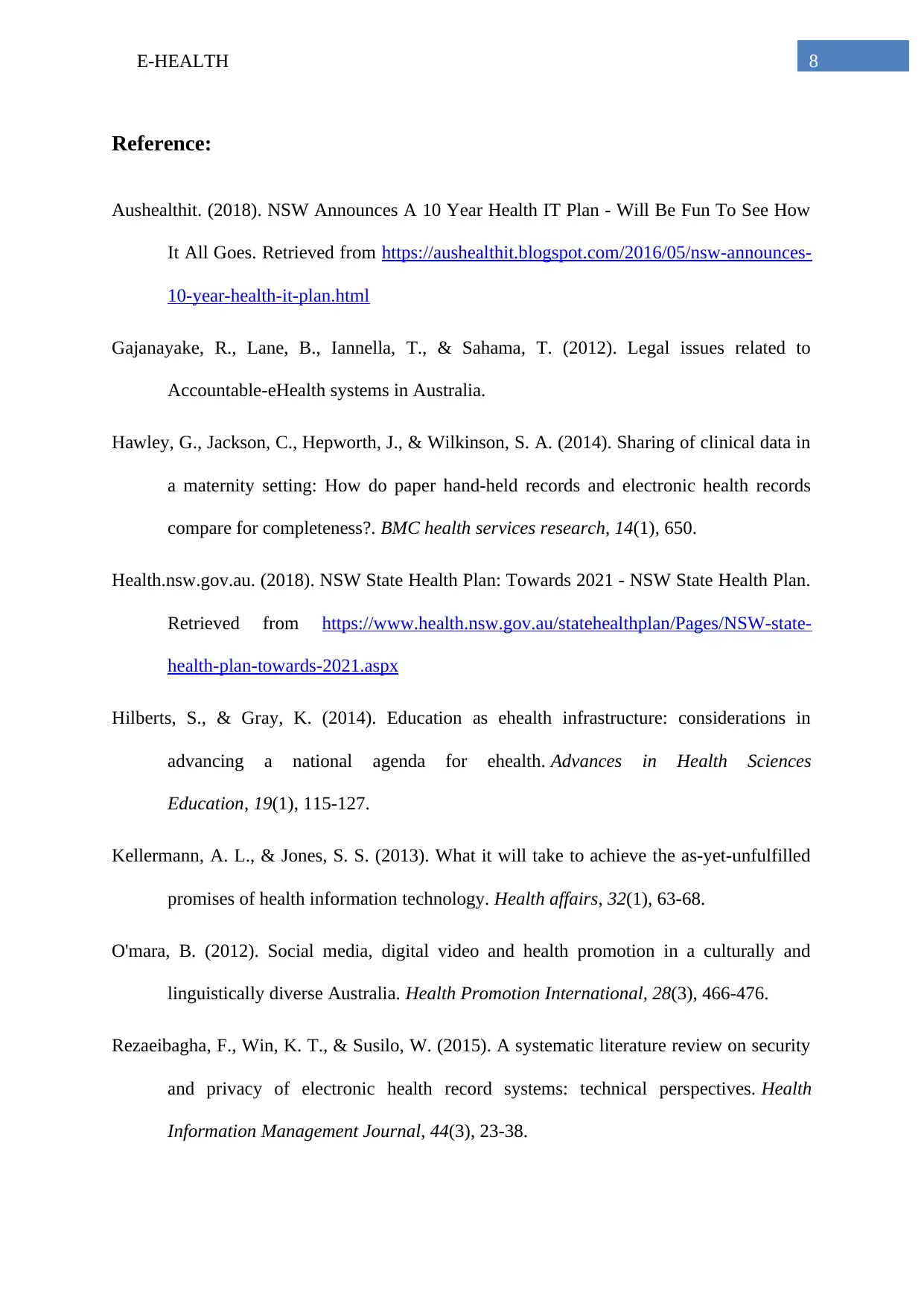
8E-HEALTH
Reference:
Aushealthit. (2018). NSW Announces A 10 Year Health IT Plan - Will Be Fun To See How
It All Goes. Retrieved from https://aushealthit.blogspot.com/2016/05/nsw-announces-
10-year-health-it-plan.html
Gajanayake, R., Lane, B., Iannella, T., & Sahama, T. (2012). Legal issues related to
Accountable-eHealth systems in Australia.
Hawley, G., Jackson, C., Hepworth, J., & Wilkinson, S. A. (2014). Sharing of clinical data in
a maternity setting: How do paper hand-held records and electronic health records
compare for completeness?. BMC health services research, 14(1), 650.
Health.nsw.gov.au. (2018). NSW State Health Plan: Towards 2021 - NSW State Health Plan.
Retrieved from https://www.health.nsw.gov.au/statehealthplan/Pages/NSW-state-
health-plan-towards-2021.aspx
Hilberts, S., & Gray, K. (2014). Education as ehealth infrastructure: considerations in
advancing a national agenda for ehealth. Advances in Health Sciences
Education, 19(1), 115-127.
Kellermann, A. L., & Jones, S. S. (2013). What it will take to achieve the as-yet-unfulfilled
promises of health information technology. Health affairs, 32(1), 63-68.
O'mara, B. (2012). Social media, digital video and health promotion in a culturally and
linguistically diverse Australia. Health Promotion International, 28(3), 466-476.
Rezaeibagha, F., Win, K. T., & Susilo, W. (2015). A systematic literature review on security
and privacy of electronic health record systems: technical perspectives. Health
Information Management Journal, 44(3), 23-38.
Reference:
Aushealthit. (2018). NSW Announces A 10 Year Health IT Plan - Will Be Fun To See How
It All Goes. Retrieved from https://aushealthit.blogspot.com/2016/05/nsw-announces-
10-year-health-it-plan.html
Gajanayake, R., Lane, B., Iannella, T., & Sahama, T. (2012). Legal issues related to
Accountable-eHealth systems in Australia.
Hawley, G., Jackson, C., Hepworth, J., & Wilkinson, S. A. (2014). Sharing of clinical data in
a maternity setting: How do paper hand-held records and electronic health records
compare for completeness?. BMC health services research, 14(1), 650.
Health.nsw.gov.au. (2018). NSW State Health Plan: Towards 2021 - NSW State Health Plan.
Retrieved from https://www.health.nsw.gov.au/statehealthplan/Pages/NSW-state-
health-plan-towards-2021.aspx
Hilberts, S., & Gray, K. (2014). Education as ehealth infrastructure: considerations in
advancing a national agenda for ehealth. Advances in Health Sciences
Education, 19(1), 115-127.
Kellermann, A. L., & Jones, S. S. (2013). What it will take to achieve the as-yet-unfulfilled
promises of health information technology. Health affairs, 32(1), 63-68.
O'mara, B. (2012). Social media, digital video and health promotion in a culturally and
linguistically diverse Australia. Health Promotion International, 28(3), 466-476.
Rezaeibagha, F., Win, K. T., & Susilo, W. (2015). A systematic literature review on security
and privacy of electronic health record systems: technical perspectives. Health
Information Management Journal, 44(3), 23-38.
⊘ This is a preview!⊘
Do you want full access?
Subscribe today to unlock all pages.

Trusted by 1+ million students worldwide
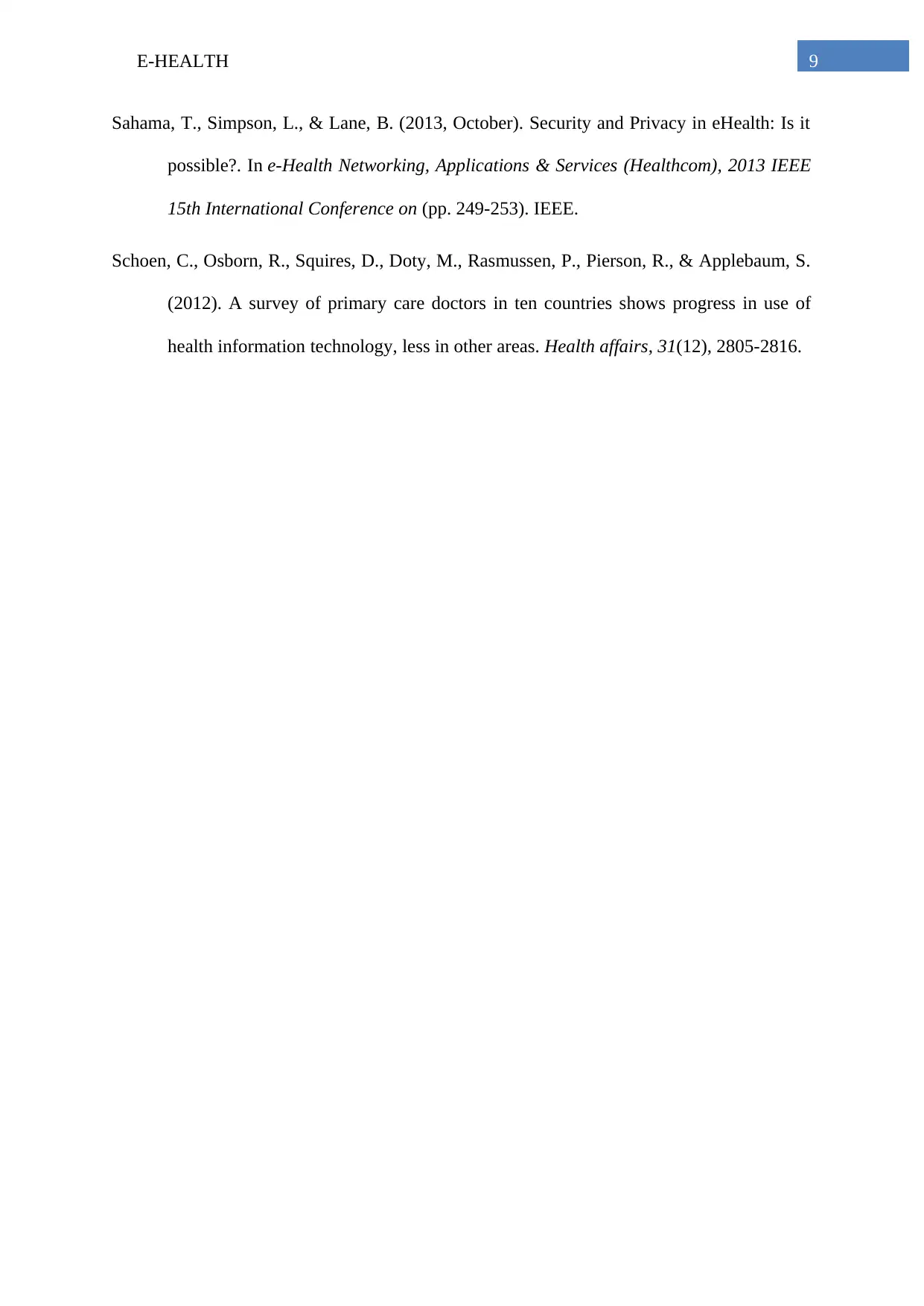
9E-HEALTH
Sahama, T., Simpson, L., & Lane, B. (2013, October). Security and Privacy in eHealth: Is it
possible?. In e-Health Networking, Applications & Services (Healthcom), 2013 IEEE
15th International Conference on (pp. 249-253). IEEE.
Schoen, C., Osborn, R., Squires, D., Doty, M., Rasmussen, P., Pierson, R., & Applebaum, S.
(2012). A survey of primary care doctors in ten countries shows progress in use of
health information technology, less in other areas. Health affairs, 31(12), 2805-2816.
Sahama, T., Simpson, L., & Lane, B. (2013, October). Security and Privacy in eHealth: Is it
possible?. In e-Health Networking, Applications & Services (Healthcom), 2013 IEEE
15th International Conference on (pp. 249-253). IEEE.
Schoen, C., Osborn, R., Squires, D., Doty, M., Rasmussen, P., Pierson, R., & Applebaum, S.
(2012). A survey of primary care doctors in ten countries shows progress in use of
health information technology, less in other areas. Health affairs, 31(12), 2805-2816.
1 out of 10
Your All-in-One AI-Powered Toolkit for Academic Success.
+13062052269
info@desklib.com
Available 24*7 on WhatsApp / Email
![[object Object]](/_next/static/media/star-bottom.7253800d.svg)
Unlock your academic potential
Copyright © 2020–2025 A2Z Services. All Rights Reserved. Developed and managed by ZUCOL.

